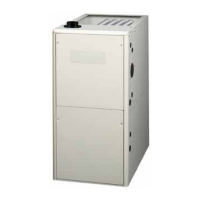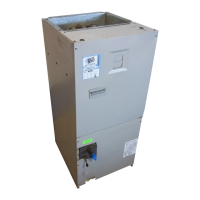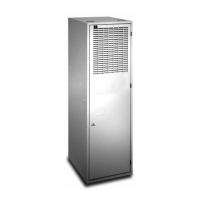8
IMPORTANT INFORMATION
• This furnace mustbeventedin compliance with
thecurrentrevisionoftheNationalFuelGasCode
(ANSI-Z223.1/NFPA54).Instructionsfordetermining
theadequacyofaninstallationcanbefoundinthe
currentrevisionoftheNFGC(ANSIZ223.1/NFPA54).
Consultlocalcodesforspecialrequirements.These
requirementsareforUSinstallationsasfoundin
theNFGC.
• Furnaceinstallationusingmethodsotherthanthose
describedinthefollowingsectionsmustcomply
with the National Fuel Gas Code (NFGC) and all
applicablelocalcodes.
• Requirements in Canada (B149.1) are structured
differently.InCanada,ventingshallconformtothe
requirementsofthecurrent(CAN/CGAB149.1or.2)
installationcodes.Consultlocalcodesforspecial
requirements.
• Provisions mustbemade during the installation
ofthisfurnacethatprovideanadequatesupplyof
airforcombustion.Thecombustionairfromthe
outside needs to be clear of chemicals that can
causecorrosion.Theinletpipeshouldnotbeplaced
nearcorrosivechemicalssuchasthoselistedon
page 5.
WARNING:
Upon completion of the furnace installation,
carefullyinspectthe entireuesystem both
insideandoutsidethefurnacetoassureitis
properlysealed.Leaksintheuesystemcan
resultinseriouspersonalinjuryordeathdue
toexposureofueproducts,includingcarbon
monoxide.
WARNING:
This furnace must not be vented with other
appliances, even if that appliance is of the
condensingtype.Commonventingcanresult
inseverecorrosionofotherappliancesortheir
venting and can allow combustion gases to
escapethroughsuchappliancesorvents.Do
notventthefurnacetoareplacechimneyor
buildingchase.
This condensing furnace is certified for installation either as
a Direct Vent (2-pipe) or Conventional (1-pipe) appliance.
Direct Vent appliances draw combustion air from the
outdoors and vent combustion products back outside.
Installation with air taken from around the furnace is often
referred to as Conventional installation - i.e. only the vent
(exhaust) pipe is provided.
Another important consideration when selecting one or
two pipe installation is the quality of the Indoor air which
can sometimes be contaminated with various household
chemicals . These chemicals can cause severe corrosion
in the furnace combustion system. A 2-pipe installation
has the additional advantage that it isolates the system
from the effects of negative pressure in the house.
CAUTION:
Exhaust fans, clothes dryers, replaces and
otherappliancesthatforceairfromthehouse
totheoutdoorscancreateanegativepressure
insidethehouse,resultinginimproperfurnace
operationorunsafeconditionssuchasameroll
out.Itisimperativethatsufcientairexchange
with the outdoors is provided to prevent
depressurization.Additionalinformationabout
testing negative pressure problems can be
foundintheNationalFuelGasCode.
Air openings on top of the furnace and openings in closet
doors or walls must never be restricted. If the furnace is
operated without adequate air for combustion, the flame
roll-out switch will open, turning off the gas supply to the
burners. NOTE:Thissafetydeviceisamanuallyreset
switch. DONOT install jumper wires across these
switchesto defeattheirfunctionor resetaswitch
withoutidentifyingandcorrectingthefaultcondition. If
a switch must be replaced, use only the correct sized part
specified in the Replacement Parts List provided online.
DirectVentSystems
Direct vent appliances draw combustion air from the
outdoors and vent combustion products back outside,
isolating the entire system from the indoor space. It is
important to make sure that the whole system is sealed
and clearances to combustibles are maintained regardless
of the installation being in a confined or unconfined space.
Conventional Vent Systems - Confined
Spaces
A confined space is an area with volume less than 50
cubic feet per 1,000 Btuh of the combined input rates of
all appliances drawing combustion air from that space.
Furnace closets, small equipment rooms and garages are
confined spaces. Furnaces installed in a confined space
which supply heated air to areas outside the space must
draw return air from outside the space and must have
the return air ducts tightly sealed to the furnace. Ducts
must have cross - sectional area at least as large as
the free area of their respective openings to the furnace
space. Attics or crawl spaces must connect freely with
the outdoors if they are the source of air for combustion
and ventilation.
The required sizing of these openings is determined by
whether inside or outside air is used to support combustion,
the method by which the air is brought to the space, and

